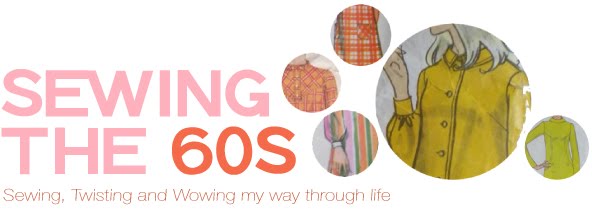While working on Simplicity 3833 for the sew along I thought I'd work on Burda 10/2011 which requests you to cut your skirt piece on the bias, and I wondered how this will make the end garment look, especially cause this pic isn't that great for detail. I decided to do some reading on grain lines and cut to understand more

I thought I should share with you my findings and explain a little about grain lines and how they affect your projects and how you can use them to your own advantage.
To start with lets look at the structure of most fabrics which should have a warp and weft grain line. The warp being the vertical grain and the weft being the horizontal grain. (Remember weft is left!)
On a 45 degree angle to this is the bias
On a 45 degree angle to this is the bias
Most pattern pieces should tell you what angle to cut the fabric on - usually it's pretty important to follow these lines as they affect the end look of your garment and because the pattern designer wants to ensure you get the same end result as their initial design.
 |
| Pattern pieces showing grain line direction arrows - Warp, Weft and Bias |
But what if your free styling and making a skirt from some left over fabric or the pattern piece doesn't indicate the grain line?
The angle of your 'cut' will create different drapes and will fit the body differently so it's handy to know which is which and how you can determine for yourself how the garment will look in the end.
For example, you plan to make an a-line skirt. You don't always need a pattern if you take your measurements and translate them to the fabric. On the below images the stripes on the fabric will demonstrate the grain line used
Cut vertically with the warp the skirt will hang simply and will look neat and not give you much fullness - giving you a perfect A shape.
Most of the dresses I make are cut on the warp grain line
On tighter garments, the bias cut helps the fabric to cling to your body which is more flattering, and something that Ossie was excellent at achieving. In the below image the sleeve and bodice of this dress are made from a non-stretch fabric cut on the bias. This method of cutting makes it stretchier in a way and moves with her body.
In my early sewing days when I was a tight ass rebel, I used to put the pattern pieces wherever they fit (usually cause I never bought enough fabric) and the end result would never fit nicely like on the pattern envelope. The sleeves would twist around and making darts fit was impossible!
So in summary, cutting the fabric on different angles will change the over all look and fit of your end garment. If you want your skirt to have more body or if you want your dress to 'cling' to your body better, cut it on the bias.
 |
| Ossie Clark & Gala Mitchell, 1974 |
Most early to mid 60's patterns are cut on the straight grain lines as the structured clean look was preferred, but by the end of the decade the 1930's look of glamorous dresses that clinged to the body and accentuated curves was more common - as we see in Ossie Clarks work. Fabric appeared to skim over the body and created movement with fabric that might not have been as compliant if cut normally, for example chiffon.
Are you a fan of bias cut clothing or Ossie Clark for that matter? Have you ever tried cutting a pattern on a different angle then instructed?
Take care dearies!
Take care dearies!















This post is a great tutorial about cutting fabric. When I began to sew also cut the pattern pieces anywhere, with time and experience, we learn to do well, this is a breakthrough. Kisses.
ReplyDeleteIm glad you liked it! seems like we all make the same rookie mistakes!
Deletesuch a good post! I used to cut fabric any which way I could too - amazing the difference following instructions can make!
ReplyDeleteThanks! Yes, instructions - sometimes their useful and sometimes better left in the envelope!
DeleteMost excellent post, love. When I started out, I also squeezed pieces in anywhere I could, not having any clue about warp/weft, bias or anything sensible!!! I had a lot of fit disasters!! I just wombled along messily, and had a few successes, enough to get me into Polytech eventually. Thank goodness! I'm still very lazy, but it really helps to have this basic information!
ReplyDeleteOssie Clark had such gorgeous designs!! I read a lot about people going on about cut/fit, and nine out of ten of them are stick insects, so obviously, fit is going to be easy. The real challenge for fit is a curvier figure, and being one, it's bloody difficult! Boobs! UGH.
Ahem.
Bias is not at all flattering to me, but on the right figure, it is divoon! I've also struggled sewing it, due to my impatience!!! I love the 30's look, soooo slinky!
You are really good as passing on information, and would be a great teacher, I bet!!! I'm lousy at it, dammit.
XXX
oh thank you! i did actually want to be a teacher once, nd perhaps deep down i still do, which is why i like these sorts of posts perhaps?
DeleteOssie is a genius - i think if anyone could make even curvy ladies look good it would have been him - bias or not, how would have figured it out im sure!
It seems that everyone make the same mistake! chucking paper on the fabric and pinning it where it lands! Oh the things we do when we're naive!
I just love Ossie Clark, his designs were just gorgeous.
ReplyDeleteLike you, when I first started sewing sometimes I would just try to squeeze the pattern pieces in to get them all to fit. I never had any problems though so maybe I was just lucky!
yes - you sound like a lucky one, unless you were just using very forgiving fabric? i know i wasnt!
Deleteyour blog is just so darling! I'm so in love with it
ReplyDeleteand for a newbie sewer, this is nice to know! <3
http://anchoriax.blogspot.com/
Thank you! Good luck with your sewing! i hope you stick to it!
DeleteI love Ossie Clark and discovered him bc I'm a big Biba fan. I love bias sewing, except for hemming. I find that I have to hang the (usually it's a skirt) for a couple days, then hem it lightly. Wear it around the house. Hang it again, bc the hem has become uneven and then re-hem it. I'm pretty good about following suggested grainline bc my Grandma told me her horror stories about when she first started sewing and didn't- (involving two velvet coats for her daughters).
ReplyDeleteoh good idea! I've had 1 dress so far that i had an issue with the hanging bit. it caused so many painful memories!
DeleteOh and velvet! gosh you wouldnt want to stuff that up!
As someone who used to do a lot of seeing (like everyone, i wanted to be a designer in middle school) this was very interesting. I like the long navy printed dress a lot as well.
ReplyDeleteI would love it if you would also check out my blog: http://afashionneverland.blogspot.com/
oh im glad you liked it! i ll go check out your blog now :)
DeleteThis was interesting! thanks for sharing all the great info, I love stuff like this.
ReplyDeletethank you! im glad you found it useful
Delete